


| [ Previous ] [ Next ] |

|
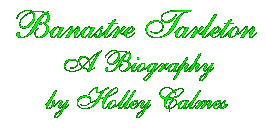
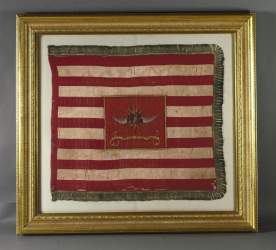 [more information] |
The spring of 1780 was spent gathering forces, planning, and taking Charleston. After the failed attempt years before, the British were not to be denied this time. On April 12th, Ban was joined by another gallant British soldier, Major Patrick Ferguson and his corps of marksmen. That evening they moved against William Washington, Huger, Horry and Pulaski at Moncks Corner, striking them at 3 a.m. The British forces routed the Patriots. After the battle, a dragoon attacked a group of women in the plantation home of Loyalist Sir John Colleton, where the ladies had taken refuge. The dragoon, and another who was attempting to loot the house, were stopped and immediately arrested. Ferguson, who was "one of the most chivalrous men in the British Army" demanded their immediate execution, but the offenders were sent to Charleston and flogged instead. Contemporary records show that Tarleton fully supported Ferguson's opinion, but his role was conveniently forgotten by later writers who embroidered the incident into an amusing piece of fiction pitting Ferguson and Tarleton against each other, creating a hostile relationship which resulted in Tarleton's lack of support of Ferguson at King's Mountain. There is no evidence of this at all. In fact, Ferguson described Tarleton in letters as a gallant young officer, and Tarleton returned the compliment in his The Campaigns by eulogizing Ferguson in highly complimentary terms.
Moncks Corner had been an attempt to plant British troops to the north of Charleston, preventing the Patriot Army from escaping north or westward. Cornwallis ordered Ban to keep moving and vigilant, watching for any signs of retreat by the Patriots. In doing so, Ban uncovered a bevy of local belles at Brabant, a plantation owned by Bishop Smith. Bass contends that this house was frequented by the Green Dragoon, and that later in life the ladies reported that "their most courteous and gallant admirer had been Banastre Tarleton."
Ban again distinguished himself by whipping William Washington at Lenud's Ferry. The siege of Charleston continued and on May 11th, General Lincoln signed the articles of capitulation. It was the costliest defeat for the Patriots in the entire war. Thousands of Patriot soldiers would languish and die on British prison ships in Charleston harbor.
Of the event Ban wrote his mother that he was "very successful here and very much befriended by Sir Henry Clinton." He ended by saying, "I shall thank you for some shirts."
As Clinton organized himself to take his troops back to New York, leaving Cornwallis and his forces to secure the South, Patriot Colonel Abraham Buford was escorting a group of men and politicos who had managed to escape the surrender at Charleston. Cornwallis ordered Ban to go after them. Buford was headed to Charlotte. The dragoons flew after him. By the afternoon of May 29th, they had caught up with Buford's troops. Tarleton sent the Patriots very generous terms of surrender -- much like those offered Lincoln at Charleston. But Buford refused them. He declared he would defend himself to the last man.
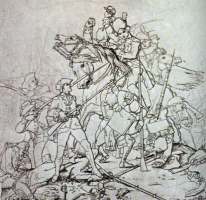 [more information] |
The dragoons charged. Buford did not allow his men to fire until the horses were almost upon them, within ten paces. This was a suicidal decision and the slaughter was terrible. The Patriots were obviously beaten from the beginning. Bass is terse about what happens next, and most American historians rely on legends and oral history taken from Patriot veterans, which only gets more embroidered with time. The most likely chain of events is that as the Patriots raised a white flag, Tarleton's horse was shot dead from under him. He went down, and his troops logically thought that their commander had been killed. Before Ban got on another mount, the troops were out of control and skewering anything that moved. There is no proof that Ban tried to stop them. And so, the legend of the Butcher was born.
After Waxhaws, upper South Carolina was quiet, at least for awhile. The Green Dragoons kept communications open between the British outposts of Fort Ninety-Six, Rocky Mount, Camden and Cheraw. It was so quiet, in fact, that Cornwallis ordered Ban to Charleston to handle augmentation and re-equipping of the cavalry. In that most graceful and beautiful city, he was quartered in the home of a leading Whig family who were given only one room of their house for their entire family. Ban and company made merry in the remainder of the house, and when the owners complained about their cramped quarters, Tarleton replied "politely," "reflection convinces me that enemies should not be allowed any conveniences."
It was now that another entertaining character enters the scene: George Hanger. This lively person had been educated in Germany and so was of great use to the British Army as an interpreter for the Hessian forces. He and Ban got along famously. So well, in fact, that Ban decided Hanger would make a ripping leader of dragoons. Going around Cornwallis, Ban wrote John André in New York to petition Clinton to change Hanger's orders. Cornwallis gave his acquiescence to the move from the beautiful river-front plantation home of Patriot William Henry Drayton, now British headquarters.
While Tarleton was in Charleston, fighting had broken out in upper South Carolina. Without their leader, several troops of Legionnaires had been sent independently to deal with the uprisings. One, Captain Huck, a Philadelphia Loyalist, had camped carelessly on a farm near Brattonsville. During the night of July 11th, his troops were surprised and Huck was killed. Tarleton was furious, and sent André a letter which hinted at frustration with Rawdon's and Cornwallis's use of his beloved dragoons. Before he could hurry back to the front, however, Ban was hit with a bout of malaria. Quickly recovering, he and Hanger were soon back in the saddle and patrolling the Black River area, on the hunt for rebellious Presbyterian militia under the commander of one Major John James.
These Patriot forces had petitioned to Baron DeKalb for a leader to unite the rebels in the South Carolina back country. They were expecting William Washington, cousin of George, and like George, a whopping big fellow. Ban and George couldn't resist a prank. With a small group of men, they took off their green coats and rode in white shirts and tan breeches to the home of the rebel leader, James Bradley where Ban introduced himself as William Washington, and used him as a guide to get them safely to Camden. (See Impersonating William Washington)
In Camden, Ban found his dragoons out of shape and out of spirits. As he began whipping them back into shape, the Patriot partisan leader Thomas Sumter, The Gamecock, began harassing British outposts, and took Rocky Mount after a fierce fight with the small group of British soldiers left there. This encouraged Sumter to write to Gates about attacking Camden itself. Cornwallis hurried back from Charleston, and began preparing his troops for the impending battle.
The battle of Camden was another decisive victory for the British. Again, a Patriot commander ran with his tail between his legs. Gates' ill-prepared troops had been fed on green corn and molasses, and few felt like fighting anything at all. The battle took place on August 16, and as the British advanced, two thirds of the Patriot forces, the militia, dropped their weapons and fled. The Delaware and Maryland regulars fought bravely until they were dispersed by Tarleton and Hanger. Gates' last words as he wheeled his horse towards Charlotte were "Let the dead bury the dead."
Sumter was not at Camden. The day after the battle, Tarleton was ordered out after the Gamecock with 350 men. By noon they were within five miles of Sumter at Fishing Creek. As Tarleton's men stealthily approached, Sumter lay asleep under a tree. The Patriots were at rest and unprepared for the charging Legion, which rode throughout the camp with sabers swinging. Sumter barely escaped, throwing himself aboard an unsaddled mount. Ban captured 300 prisoners and forty-four wagons loaded with supplies, and released one hundred British prisoners. There is no mention of prisoners sabered or executed point blank.
This great success brought more fame to the Green Dragoon. Cornwallis wrote to Lord Amherst, "Your Lordship will see the account of the brilliant action of Lt. Colonel Tarleton; I think it is my duty to declare that he is one of the most promising young officers I ever knew...." This letter was presented to King George himself, and was published in the London Gazette Extraordinary on October 9th, 1780. Ban was now officially a national hero.
During September, with the Patriot forces largely decimated, the Patriot cause fell back upon guerrilla tactics to survive. Francis Marion was a plantation owner of French Huguenot descent, another partisan who had missed being at Camden. He now began harassing the British lines of communication.
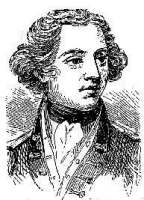 [more information] |
Cornwallis, meanwhile, believing South Carolina sufficiently subdued, was confident enough to push into North Carolina. These plans were waylaid by his cavalry commander becoming dangerously ill. Ban had contracted yellow fever, and the army was paralyzed until he was safe to move. Although his friend Hanger tried to lead the Green Horse, Hanger wasn't Tarleton, and enjoyed no success. Cornwallis wrote, "Indeed, the whole of them are very different when Tarleton is present or absent."
Now Hanger became violently ill. He kept himself alive with a treatment of opium and port wine, and by some miracle he survived. But now both Tarleton and Hanger were out of commission. Recuperating but immobile throughout the end of September, they were of no help to Major Patrick Ferguson, who was leading his Loyalist troops to join Cornwallis at Charlotte. Ferguson requested backup, writing "three or four hundred good soldiers, part dragoons, would finish the business. Something must be done soon." But Cornwallis was not alarmed. In fact, he seemed more concerned with Tarleton's recuperation.
On October 7th, gallant Patrick Ferguson met an untimely end at the Battle of King's Mountain. It was more of a hill than a mountain and the terrain allowed Shelby, Campbell and Cleveland's riflemen to hide behind trees as they picked off Loyalists. Ferguson died bravely, rallying his men for one last charge as at least eleven bullets ripped through his body. The only British soldier on the field that day, he was wrapped in raw cowhide along with his mistress, Virginia Sal, who had died while tending the wounded. Some might argue that the Patriot forces behaved with less honor than Tarleton's troops at Waxhaws. Before burying Ferguson, it is reported in many accounts that the victors urinated on his corpse. Later, they hanged a group of Loyalist prisoners without benefit of trial. One of the Patriot leaders, Benjamin Cleveland, was truly as barbaric as Ban was attributed to be. Cleveland had severed the arms from two Loyalist prisoners before the battle, both men very elderly. He was also reputed to encourage his two adolescent sons to hang Loyalists whenever they caught them without benefit of trial. These war crimes never come to popular attention, as history is indeed written by the victors.
By October 10, Ban was back in the saddle. Cornwallis was uninformed of the tragedy at King's Mountain, and ordered him to ride in support of Ferguson. Upon learning of the fate of the brave major, he forwarded the unhappy news to Cornwallis who recalled him to seek out winter quarters for the British Army. Ban chose Winnsborough (Winnsboro), SC.
Meanwhile, Francis Marion had increased his guerrilla attacks. Cornwallis allowed Tarleton to seek out the elusive Marion, although he did not understand how bands of only ten or twelve men could cause so much trouble. Tarleton prepared his Legion for pursuit of this cagey enemy and was soon on the hunt. Tarleton chased Marion throughout the countryside, and on November 8th rode seven hours "through swamps and defiles." Twenty-three miles above Kingstree, Tarleton halted his tired men and horses and, according to Bass, "cried in the thick accents of Lancashire, 'Come my boys! Let us go back and we will find the Gamecock. But as for this damned old fox, the devil himself couldn't catch him.'" Thus Marion's nickname, The Swamp Fox, purportedly has its origins.
Frustrated, Ban unleashed his "boys" upon the countryside, where they burned and plundered. The ramble led the Green Dragoon to another bizarre adventure at the plantation of General Richardson, a Patriot leader who had died some six weeks before. Perhaps emotionally stricken by the hanging of his friend John André just a short time before, Tarleton had the old General dug up from his grave so that he might "look upon the face of so brave a man." Some surmise he was looking for the family silver, or perhaps he simply wanted to make sure Richardson was indeed dead instead of hiding in the swamps. Nevertheless, after dining at Richardson's plantation house, he had the livestock driven into the barn and put the house and barn to the torch. There is no record of humans being harmed beyond being left homeless and hungry.1
This story is noteworthy in that it has lived on in a variety of tales. One has Ban returning to America after the war to dig up the body of a fellow British officer whom he detested, to gloat over the corpse. Nonsense, of course, but it is yet another example of how Tales of Tarleton flourish and are taken at face value by many. The more dreadful the story, the better to his detractors. At least he inspires creativity.
The next day he issued a proclamation to the inhabitants which ended with the sentiment that, "It is not the wish of Britain to be cruel or to destroy, but it is now obvious to all Carolina that Treachery, Perfidy, and Perjury will be punished with instant Fire and Sword." This adventure was immediately followed by the announcement that Ban's superiors had recommended him for the rank of lieutenant colonel in the British Army. (His previous rank of lieutenant colonel was a brevet rank in a temporarily constructed Loyalist corps. He was a major in the regular army.)
Next Ban focused on Sumter. As he tracked the Gamecock, Cornwallis wrote perhaps his most admiring accolade on his favorite dragoon. "I wish you would get three Legions and divide yourself into three parts. We can do no good without you."
Tarleton and Sumter clashed at a farm belonging to the Blackstock family. After relentlessly pursuing Sumter, he found him in an almost impregnable position. On November 21, the greatly outnumbered British forces fought hand to hand with Sumter's men as they awaited their cannon and infantry. Sumter had charged first, having an advantage of number and secure position. However, during the battle, Sumter was seriously wounded. By the end of the battle, Tarleton's men had been driven back, although they had "cut Sumter's rear guard to pieces." Tarleton claimed a victory, although technically it was not because Sumter held the field. However, in the long run, the British could be satisfied. Sumter's wound kept him effectively out of the war for its duration, and broke his spirit. Tarleton wrote of Sumter being "mortally wounded," and he might as well have been.
December 1780 had the Legion encamped and resting. Ban had unhappy news from home, however. His request to be put up for Parliament had been defeated. Although he was a national war hero, he wasn't yet well enough known to begin a political career. Also, his brother John had tried unsuccessfully to obtain a legacy from his Aunt Parker's estate to pay off the ubiquitous gambling debts. Unable to secure the funds, John sent a keg of wine instead. In a letter of thanks Ban writes, "I have had many hair breadth Escapes since my last -- my good Genius still smiles -- I hope will hover around me till I once more see my native Country."
 Banastre Tarleton, Lt. Col. B.L. |
Tarleton's hovering genius was fading, if only temporarily. The secretary of war had denied his promotion to full lieutenant colonel in the British Army, which must have been a great disappointment. He wrote of it, "The more difficulty, the more glory." Indeed, a more formidable foe than he had ever met was waiting in the wings. On December 18th, Cornwallis wrote him that Daniel Morgan was now in South Carolina with his "corps and cavalry." Morgan was the true hero, along with Arnold, of the superb Patriot victory at Saratoga. In addition to Morgan, Nathanael Greene took over command of Gates' Army. With this new leadership in place, the fortunes of war would change.
Immediately after Christmas, Cornwallis summoned Tarleton to talk winter strategy. Although reinforcements were coming to replace Ferguson's troops, Cornwallis was concerned for the safety of Loyalists they would leave behind as they pushed into North Carolina, particularly with Morgan and Greene gathering strength. Something had to be done. Fort Ninety-Six, a bastion of safety for the Loyalists and holding a wealth of supplies, must be protected. Ban was ordered to do this, pushing Morgan as closely as possible as he went. But the intelligence reports were wrong. Morgan was not threatening Fort Ninety-Six at all. He had "retired" to the Broad River area. Tarleton outlined his plan to Cornwallis to advance on Morgan, but he would need more men and supplies. Cornwallis, "like a proud and indulgent father," sent Ban everything he asked. Meanwhile, the Patriot forces were gathering also. Militia were flocking to Morgan's camp.
The first week in January was deluged by winter rains. Rivers were flooded and communications interrupted. Although Ban and Cornwallis wrote every day, by the next week Cornwallis admitted he had not heard from the young dragoon for days. By January 12th, intelligence reported to Tarleton that Morgan was at Grindal Shoals, then was retreating to Burr's Mill on Thickety Creek. Tarleton chased his quarry and misdated his letters so that Cornwallis became somewhat confused. In a dispatch of January 14th, Cornwallis promised to head towards specific locations within the next two days. But he was not concerned. He wrote Balfour, "I have as yet heard no news from Broad River, but I always trust that where Tarleton is things will go on well." Tarleton was silent until January 16th. Playing cat and mouse with Morgan for days, he finally wrote, "I have been most cruelly retarded by the waters. Morgan is in force and gone for Cherokee Ford. I am now on my march. I wish he could be stopped." During the day a Patriot colonel was captured and his information told that Morgan was expecting reinforcements and was about to cross Broad River. This was something Tarleton wished to prevent.
At 3 a.m. on the morning of the 17th, Tarleton broke camp and began his march towards Morgan. Within several hours they were within five miles of the enemy. This enemy was led by a talented leader. Daniel Morgan had hated the British since childhood. He had been brilliant during the earlier days of the war, and only escaped being at Camden because he had become very ill with malaria and spent the fall of 1780 in his home state of Virginia. Even at Cowpens he was still weak and suffering terribly from sciatica. But he was still razor sharp. He knew Ban's method of attack depended on surprise and sudden attack. He planned accordingly.
The story of Cowpens has changed recently, as new facts have been brought to light. An excellent book, Dr. Lawrence Babits' A Devil of a Whipping presents the history with new perspective. Although not fond of Tarleton, Babits is one of the only American historians to give Tarleton his due and present a fair account of both Tarleton's behavior and of the battle. Together with information gathered by historian Dr. Bobby Moss of Limestone College, SC, Babits' account is the most accurate picture of the battle written thus far. His information explains much of what happened. Essentially the battle was won by Morgan's brilliant tactics. The terrain at Cowpens is fairly well preserved, and it is extremely deceptive. What looks like a flat or gently rolling field is actually rolling to a greater extent, allowing rows of men to be well concealed from a distance. Morgan put his militia, whose dependability was always questionable, in three lines across this field. He ordered them to fire twice and retreat in order. It looked like a retreat, but it was not. As one line wheeled and retired, the next line stood and fired. In simple terms, knowing Tarleton's headstrong modus operandi, Morgan believed he could trap the British, then flank them. It worked brilliantly.
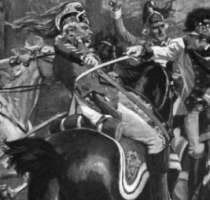 [more information] |
Babits brings new facts to the table. Morgan was supposed to have had approximately 2,000 men in the battle. Tarleton had somewhat less, although he did have the Legion and a couple of small cannon. Yet Dr. Bobby Moss' geneological research shows that Morgan had many more. Records with the Veteran's Administration show a much higher number of senior citizens asking for veterans relief based on being at Cowpens, and these petitions required substantiation. Naturally, both commanders would want to cut their numbers down: Tarleton to excuse himself, Morgan to say he whipped 'em with fewer men. Thanks to Dr. Moss, this boast no longer rings true.
Another interesting fact is that many of the British Legion were replacements for men killed and wounded. A number of these were Patriot soldiers captured at the battle of Camden. In lieu of being sent to the Charleston Harbor prison ships, they had taken an oath of loyalty to the King and were pressed into service. When these men saw what was happening on the battlefield, they literally threw down their guns and surrendered to their friends. Tarleton later wrote in wonder at the misbehavior of his beloved Legion, as though they were a totally different corps. Many of them were very different indeed.
In the long run, the fact remains that Tarleton lost and Morgan won. Tarleton should have rested his men before throwing them into battle in the early morning. They were tired and hungry. The shock of battle, the noise, the fear, is barely supportable for a well-rested man. Imagine the psychological effects on men who have marched in the rain all night and are suddenly asked to fight before breakfast. This must have had an influence on the British forces. And the fact also remains that Ban was a twenty-six year old with five years of military experience. No matter his personal bravery, he lacked experience, and the command at Cowpens was the largest he had ever led. Morgan had decades of experience and the brains to go with it. Morgan simply won the battle, and no amount of excuse can change that fact.
Added to the misery of the loss was the fact that Ban was not universally liked by his fellow officers. Many called him "that boy" and were jealous of his meteoric rise even though it had been deserved. Now they could gloat. Ban could also feel that Cornwallis had not supported him. Cornwallis was supposed to have been nearby at King's Mountain, but he spent the day grinding corn at Turkey Creek instead. There is a story that upon reporting to Cornwallis about the total rout of his forces, Cornwallis leaned so hard upon his sword that it snapped in half. He did write Lord Rawdon, "The late affair has almost broke my heart." Whatever he felt, he did not accept Tarleton's offer of resignation. Instead he wrote, "You have forfeited no part of my esteem as an officer by the unfortunate event of the action of the 17th.......the total misbehavior of the troops could alone have deprived you of the Glory you deserved."
After Cowpens, Cornwallis braved the rains and floods of upper South Carolina in pursuit of Morgan, who was bobbing and weaving about the countryside. Morgan was suffering greatly from his sciatica and the weather didn't help.
When Greene learned of Cowpens, he left his position at Hick's Creek and on February 5 and 6 the combined forces of Morgan, Huger and Greene gathered at the mid-North Carolina town of Guilford Courthouse. Ban was trailing them, and skirmished with Light-Horse Harry Lee's rear guard. Ban was trying to find the main Patriot army. Cornwallis "lashed his troops forward" in pursuit.
One interesting event occurred on February 23rd when a group of 600 Loyalist militia under Colonel Pyle met a squadron of green-coated dragoons about a mile from Tarleton's camp. Believing them to be the Legion, they saluted these horsemen with "God Save the King." It wasn't the Legion, it was Lee, and he cut the militia to pieces, killing 90 and wounding 150. According to Bass, "the quality of Lee's mercy was far worse than Tarleton's at the Waxhaws."
Pyle's massacre dampened the spirits of both Tories and Patriots. Neither Cornwallis nor Greene could rely on local reinforcement, and a battle was approaching as Cornwallis bore down on Greene.
On March 14th, Cornwallis decided to fight. He sent Ban and the Legion out in advance, and there was a skirmish in which Tarleton's right hand was shot. Later in the day, Harry Lee sent Tarleton a written request asking about the condition of certain prisoners Tarleton had taken. Ban replied, apologizing for not writing himself as he had "taken a ball in my right hand during our morning encounter." Polite, indeed.
As preparation for battle ensued, Cornwallis ordered the Legion in reserve "until the infantry could penetrate through the woods to the open ground near the courthouse." After two hours of heated conflict the outcome was still in doubt. Tarleton saw much action and was again wounded. His personal bravery was later recognized by Cornwallis in several letters. The British claimed the field, but at such a great cost that Greene could also claim a pyrrhic victory. Cornwallis had found it necessary to fire grapeshot on his own men, and losses were extremely heavy.
After the battle Ban's first two fingers on his right hand were amputated. His spirits were naturally low in the ensuing few days, and he addressed Cornwallis with a request to retire from military duty. Cornwallis wouldn't let him. As Bass so aptly puts it, "Ban Tarleton with one hand was better than most of his other officers with two." So Ban began practicing writing and sword exercises with his left hand, and wrote his brother John about the wound. Shortly afterwards he probably dictated an adorable letter to his favorite sibling, his sister Bridget. The letter sparkles with the charm of a young man full of wit and affection. It is a very valuable insight into what this character was all about.
As Ban recuperated during the spring, Cornwallis was working on behalf of his favorite young officer and the Legion. His efforts were finally successful, and on June 15th Ban was officially promoted to lieutenant colonel in the British Army proper. His title was lieutenant colonel of the 79th Regiment, by order of the King. The description of Tarleton from the official recommendation read, "He is indefatigably laborious and active, cool and intrepid in action, discerns by intuition, seizes with rapidity, and improves with skill the short but favorable decisive moments of victory."
At this point Cornwallis could not decide whether to advance into Virginia or retreat into South Carolina. Deciding finally upon Virginia, the Army began the march towards Yorktown on April 25th. During the march Cornwallis ordered that there would be no looting, pillaging, or disturbing of the inhabitants upon pain of death. Tarleton was a day ahead of the main body of the Army, meeting a little resistance but quickly overcoming it.
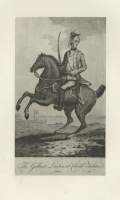 [more information] |
Over the next several weeks, the British Army sought out the Patriot troops. They crossed the James River, and during a small skirmish, the dragoons captured a Patriot packet of letters. One of the letters was from Lafayette to Jefferson, and it told of an upcoming meeting of the Virginia General Assembly in Charlottesville. Ban was dispatched to capture Jefferson. With 250 men, he set out on daybreak of June 3rd.
As Ban was galloping past the Cuckoo Tavern in eastern Louisa County, a young Virginia militiaman named John Jouette recognized the British Legion's uniforms and guessed the prey they were after. As night fell, he took possession of the fastest horse in seven counties and while Tarleton's men camped for the night, made his way on back country roads to Charlottesville.
Jefferson escaped from Monticello ten minutes before Tarleton rode to the front door. Later, Jefferson was asked how his home had fared under the "care" of Butcher Tarleton. Jefferson replied that nothing was touched. Cornwallis however, destroyed several of his barns.
The next several weeks were again spent with the two Armies marching about southern Virginia. A small battle with Lafayette had sent the young Frenchman back to lick his wounds. Ban and his dragoons scavenged the foot of the Blue Ridge and made off with "the best-blooded horses in America." It is probably during this period that the infamous "black stallion" story originated. This tale concerns Ban breaking a huge black horse. Its source is a memory of an old Tory waxing poetic in an 1861 biography of Andrew Jackson by James Parton. Ban is pictured as superhuman, and the story is probably as exaggerated as the Butcher Boy stories told by Patriots. It is true, however, that the Legion burned, looted and took prisoners throughout the region. (For one opinion of the truth behind this incident, check out the related Banecdote.)
On August 14th, Cornwallis ordered the Legion to follow him to Yorktown. Clinton had written him to stay put in Williamsburg, but Cornwallis's aides disapproved of the logistics in terms of defense and insisted on moving to Yorktown and Gloucester. While Cornwallis built fortifications and Ban "terrorized the local militia," Clinton was assembling reinforcements in New York. But, on August 30th, De Grasse appeared in the Chesapeake with 28 war ships. In addition, a letter three days later reported that Washington was marching south with his segment of the Patriot Army. The siege had begun.
Clinton had written Cornwallis in his letter of September 2 that if Washington was indeed on his way, "I shall endeavor to either reinforce the army under your command by all means within the compass of my power or make every possible diversion in your favor." Clinton did nothing, and the predicament Cornwallis endured was fuel for a later duel of words.
On the evening of October 2 Cornwallis at last decided to transfer his cavalry out of the besieged town. Tarleton and company crossed the York River to the Gloucester peninsula. At daybreak the next morning detachments of dragoons were sent out to forage when suddenly the hussars of the Duc du Lauzun appeared. The Duc, a thirty-four year old French nobleman, would later become a great friend of Ban's, but at Gloucester he was out to kill him. He almost succeeded. The Duc described it this way: "I charged without stopping. Tarleton picked me out, and came to me with his pistol raised. We were going to fight between our respective troops when his horse was thrown down by one of his dragoons who was being pursued by one of my lancers. I ran on him to take him prisoner. A company of English dragoons threw itself between us and protected his retreat. His horse was left to me."
This was Tarleton's last military action. His life would afford him much action of a different sort, but his military career would never be as bright again.
 [more information] |
After the surrender at Yorktown, Ban was intentionally excluded from the social interaction that occurred between the British and Patriot officers. Not only would the Patriots not eat with him, someone tried to kill him. He feared for his life, knowing how the enemy hated him, and so he asked the French for protection. A story circulated in a 1782 newspaper that the bed Tarleton was to have slept in had been stabbed repeatedly. Fortunately, it was empty.
Rochambeau, like a good ally, snubbed Ban as well, but other Frenchmen did not. As his continental exploits during the next decade suggest, Ban probably spoke fluent French and some German. Lauzun took Ban under his wing and another interesting friendship began, only to end when the French nobleman faced the mobs of Paris on the guillotine a decade later.
Cornwallis and Company arrived in New York on November 19th after signing their paroles. There was a rumor that Cornwallis was to challenge Clinton to a duel for not having relieved him at Yorktown. According to Bass, Tarleton had always preferred Clinton, "a plain professional soldier," to either Cornwallis or Rawdon. Besides, George Hanger was in New York, returned from a convalescence in Bermuda. Additionally, one of George III's sons, the very young Duke of Clarence, was in the city and befriended Ban. For a defeated Army and its officers, New York offered a merry time of partying and renewed friendships.
On December 15th, a convoy of 150 ships hoisted anchor, bound for Britain and home. Tarleton was among the passengers. Unfortunately, it was not a pleasure trip. A terrible storm scattered the ships. As they came limping into the mouth of the English Channel, French privateers smelled a prize. The result was that Colonels Tarleton, Dundas and Lake were captured aboard the British ship London and transferred to the French ship La Sensibilite. Yet another storm blew this ship off course and instead of Boulogne, they wound up in Dungeness, where the three officers paid a ransom of £400 and were set ashore.
| [ Previous ] [ Next ] |
1 Holley's opinion of the Richardson visit and mine differ. I can find no contemporary evidence whatsoever to support the idea that Richardson was exhumed, and considerable evidence to refute it. For an alternate view, see my article on the subject. -- Marg B. [ back ]
| Return to the Main Page | Last updated by the Webmaster on July 3, 2006 |